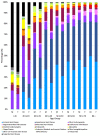Sex differences in the etiology and burden of heart failure across country income level: analysis of 204 countries and territories 1990-2019
- PMID: 36577147
- PMCID: PMC10627811
- DOI: 10.1093/ehjqcco/qcac088
Sex differences in the etiology and burden of heart failure across country income level: analysis of 204 countries and territories 1990-2019
Abstract
Background: Heart failure (HF) is a global epidemic.
Objective: To assess global sex differences in HF epidemiology across country income levels.
Methods and results: Using Global Burden of Disease (GBD) data from 204 countries and territories 1990-2019, we assessed sex differences in HF prevalence, etiology, morbidity, and temporal trends across country sociodemographic index or gross national income. We derived age-standardized rates. Of 56.2 million (95% uncertainty interval [UI] 46.4-67.8 million) people with HF in 2019, 50.3% were females and 69.2% lived in low- and middle-income countries; age-standardized prevalence was greater in males and in high-income countries. Ischaemic and hypertensive heart disease were top causes of HF in males and females, respectively. There were 5.1 million (95% UI 3.3-7.3 million) years lived with disability, distributed equally between sexes. Between 1990 and 2019, there was an increase in HF cases, but a decrease in age-standardized rates per 100 000 in males (9.1%, from 864.2 to 785.7) and females (5.8%, from 686.0 to 646.1). High-income regions experienced a 16.0% decrease in age-standardized rates (from 877.5 to 736.8), while low-income regions experienced a 3.9% increase (from 612.1 to 636.0), largely consistent across sexes. There was a temporal increase in age-standardized HF from hypertensive, rheumatic, and calcific aortic valvular heart disease, and a decrease from ischaemic heart disease, with regional and sex differences.
Conclusion: Age-standardized HF rates have decreased over time, with larger decreases in males than females; and with large decreases in high-income and small increases in low-income regions. Sex and regional differences offer targets for intervention.
Keywords: Epidemiology; Female; Global Burden of Disease; Male; Morbidity.
© The Author(s) 2022. Published by Oxford University Press on behalf of the European Society of Cardiology.
Conflict of interest statement
None.
Figures






References
-
- Sullivan K, Doumouras BS, Santema BT, Walsh MN, Douglas PS, Voors AAet al. Sex-specific differences in heart failure: pathophysiology, risk factors, management, and outcomes. Can J Cardiol. 2021;37:560–571. - PubMed
-
- GBD 2019 Tobacco Collaborators . Spatial, temporal, and demographic patterns in prevalence of smoking tobacco use and attributable disease burden in 204 countries and territories, 1990-2019: a systematic analysis from the Global Burden of Disease Study 2021. Lancet North Am Ed. 2021;397:2337–2360. - PMC - PubMed
-
- Gerdts E, Sudano I, Brouwers S, Borghi, C, Bruno, RM, Ceconi, Cet al. Sex differences in arterial hypertension: a scientific statement from the ESC council on Hypertension, the European Association of Preventive Cardiology, Association of Cardiovascular Nursing and Allied Professions, the ESC Council for Cardiology Practice, and the ESC Working Group on Cardiovascular Pharmacotherapy. Eur Heart J. 2022;43:4777–4788. - PMC - PubMed
-
- Tooher J, Thornton C, Makris A, Ogle R, Korda A, Hennessy Aet al. All hypertensive disorders of pregnancy increase the risk of future cardiovascular disease. Hypertension. 2017;70:798. - PubMed
Publication types
MeSH terms
Grants and funding
LinkOut - more resources
Full Text Sources
Medical
Research Materials
Miscellaneous

